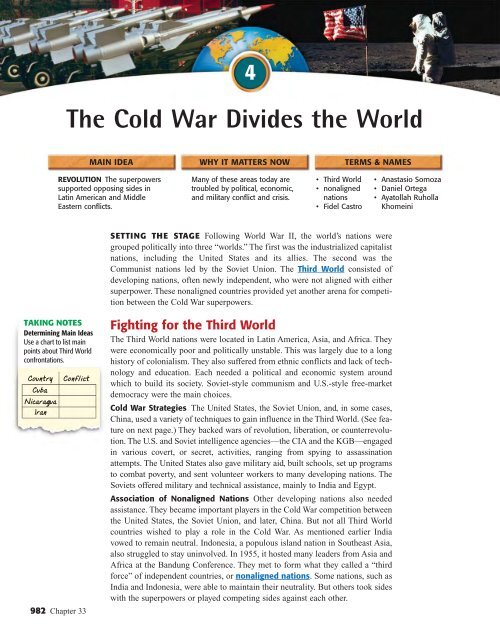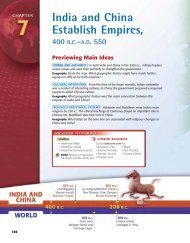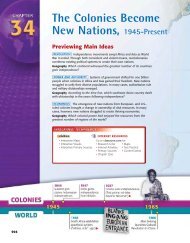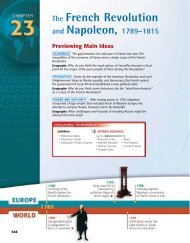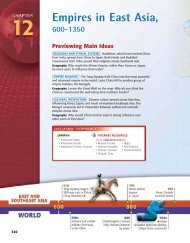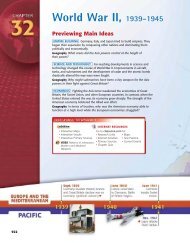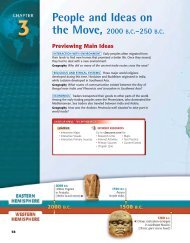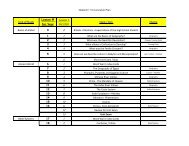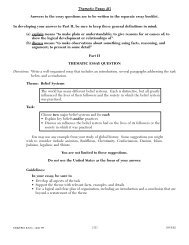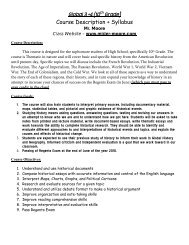Restructuring the Postwar World, - First
Restructuring the Postwar World, - First
Restructuring the Postwar World, - First
Create successful ePaper yourself
Turn your PDF publications into a flip-book with our unique Google optimized e-Paper software.
TAKING NOTES<br />
Determining Main Ideas<br />
Use a chart to list main<br />
points about Third <strong>World</strong><br />
confrontations.<br />
Country Conflict<br />
Cuba<br />
Nicaragu g a<br />
Iran<br />
982 Chapter 33<br />
The Cold War Divides <strong>the</strong> <strong>World</strong><br />
MAIN IDEA WHY IT MATTERS NOW TERMS & NAMES<br />
REVOLUTION The superpowers<br />
supported opposing sides in<br />
Latin American and Middle<br />
Eastern conflicts.<br />
4<br />
Many of <strong>the</strong>se areas today are<br />
troubled by political, economic,<br />
and military conflict and crisis.<br />
• Third <strong>World</strong><br />
• nonaligned<br />
nations<br />
• Fidel Castro<br />
SETTING THE STAGE Following <strong>World</strong> War II, <strong>the</strong> world’s nations were<br />
grouped politically into three “worlds.” The first was <strong>the</strong> industrialized capitalist<br />
nations, including <strong>the</strong> United States and its allies. The second was <strong>the</strong><br />
Communist nations led by <strong>the</strong> Soviet Union. The Third <strong>World</strong> consisted of<br />
developing nations, often newly independent, who were not aligned with ei<strong>the</strong>r<br />
superpower. These nonaligned countries provided yet ano<strong>the</strong>r arena for competition<br />
between <strong>the</strong> Cold War superpowers.<br />
Fighting for <strong>the</strong> Third <strong>World</strong><br />
The Third <strong>World</strong> nations were located in Latin America, Asia, and Africa. They<br />
were economically poor and politically unstable. This was largely due to a long<br />
history of colonialism. They also suffered from ethnic conflicts and lack of technology<br />
and education. Each needed a political and economic system around<br />
which to build its society. Soviet-style communism and U.S.-style free-market<br />
democracy were <strong>the</strong> main choices.<br />
Cold War Strategies The United States, <strong>the</strong> Soviet Union, and, in some cases,<br />
China, used a variety of techniques to gain influence in <strong>the</strong> Third <strong>World</strong>. (See feature<br />
on next page.) They backed wars of revolution, liberation, or counterrevolution.<br />
The U.S. and Soviet intelligence agencies—<strong>the</strong> CIA and <strong>the</strong> KGB—engaged<br />
in various covert, or secret, activities, ranging from spying to assassination<br />
attempts. The United States also gave military aid, built schools, set up programs<br />
to combat poverty, and sent volunteer workers to many developing nations. The<br />
Soviets offered military and technical assistance, mainly to India and Egypt.<br />
Association of Nonaligned Nations O<strong>the</strong>r developing nations also needed<br />
assistance. They became important players in <strong>the</strong> Cold War competition between<br />
<strong>the</strong> United States, <strong>the</strong> Soviet Union, and later, China. But not all Third <strong>World</strong><br />
countries wished to play a role in <strong>the</strong> Cold War. As mentioned earlier India<br />
vowed to remain neutral. Indonesia, a populous island nation in Sou<strong>the</strong>ast Asia,<br />
also struggled to stay uninvolved. In 1955, it hosted many leaders from Asia and<br />
Africa at <strong>the</strong> Bandung Conference. They met to form what <strong>the</strong>y called a “third<br />
force” of independent countries, or nonaligned nations. Some nations, such as<br />
India and Indonesia, were able to maintain <strong>the</strong>ir neutrality. But o<strong>the</strong>rs took sides<br />
with <strong>the</strong> superpowers or played competing sides against each o<strong>the</strong>r.<br />
• Anastasio Somoza<br />
• Daniel Ortega<br />
• Ayatollah Ruholla<br />
Khomeini


